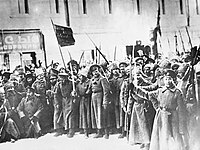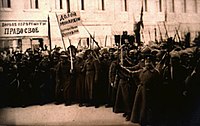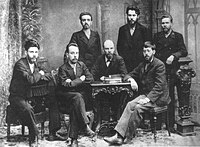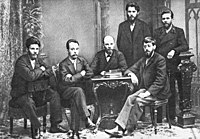Censorship of images in the Soviet Union: Difference between revisions
→Flag on the Reichstag: proper links |
→Lenin's Speech: citation needed |
||
| Line 13: | Line 13: | ||
==Lenin's Speech== |
==Lenin's Speech== |
||
{{Multiple image|direction=vertical|align=right|image1=RedSqlenintrotsky.jpg|image2=Lenin addressing the troops - May 5 1920 - Altered.jpg|width=200|caption2=Trotsky is seen in the foreground with [[Lev Kamenev]]. The photo was later altered and both were removed by censors.}} |
{{Multiple image|direction=vertical|align=right|image1=RedSqlenintrotsky.jpg|image2=Lenin addressing the troops - May 5 1920 - Altered.jpg|width=200|caption2=Trotsky is seen in the foreground with [[Lev Kamenev]]. The photo was later altered{{cn|It looks more rather like two slightly different photos than a single with edited-out persons - the illumination of the background, the angle of view etc.}} and both were removed by censors.}} |
||
On May 5, 1920, Lenin gave a famous speech to a crowd of Soviet troops in [[Sverdlov Square]], Moscow. In the foreground was [[Leon Trotsky]] and [[Lev Kamenev]]. The photo was later altered and both were removed by censors. |
On May 5, 1920, Lenin gave a famous speech to a crowd of Soviet troops in [[Sverdlov Square]], Moscow. In the foreground was [[Leon Trotsky]] and [[Lev Kamenev]]. The photo was later altered and both were removed by censors. |
||
Revision as of 19:49, 19 April 2011

After Joseph Stalin rose to power in the Communist Party of the Soviet Union and became Soviet leader, he initiated a number of purges that eliminated perceived enemies. At first, a purge meant expulsion from the Communist Party, but after the Great Purge in the 1930s members were arrested, imprisoned, sent to gulags or to internal exile in Siberia, or executed. The Soviet government attempted to erase some purged figures from Soviet history, and took measures which included altering images, destroying film, and in the most extreme cases, killing off entire families.[A 1]
The Water Commissar
This image taken by the Moscow Canal was taken when Nikolai Yezhov was water commissar. After he fell from power, he was arrested, shot, and his image removed by the censors.
Nikolai Yezhov
Yezhov was born in Saint Petersburg and from 1915 to 1917, Yezhov served in the Tsarist Russian army. He joined the Bolsheviks on May 5, 1917 in Vitebsk, a few months before the October Revolution. During the Russian Civil War 1919–1921 he fought in the Red Army. After February 1922, he worked in the political system rising in 1934 to the Central Committee of the Communist Party; in the next year he became a secretary of the Central Committee. From February 1935 to March 1939 he was also the Chairman of the Central Commission for Party Control.
In 1935 he wrote a paper in which he argued that political opposition must eventually lead to violence and terrorism; this became in part the ideological basis of the Purges.[1] He became People's Commissar for Internal Affairs (head of the NKVD) and a member of the Presidium Central Executive Committee on September 26, 1936. Under Yezhov, the purges reached their height, with roughly half of the Soviet political and military establishment being imprisoned or shot, along with hundreds of thousands of others, suspected of disloyalty or "wrecking." Yezhov himself fell out of Stalin's favour and on April 10, 1939 he was arrested and on February 4, 1940 he was shot.[2]
Lenin's Speech
On May 5, 1920, Lenin gave a famous speech to a crowd of Soviet troops in Sverdlov Square, Moscow. In the foreground was Leon Trotsky and Lev Kamenev. The photo was later altered and both were removed by censors.
Leon Trotsky
Leon Trotsky (Russian: Лeв Давидович Трóцкий) was a Ukrainian-born Bolshevik revolutionary and Marxist theorist. He was an influential politician in the early days of the Soviet Union, first as People's Commissar for Foreign Affairs and later as the founder and commander of the Red Army and People's Commissar of War. He was also among the first members of the Politburo.
He became an enemy of the State and was erased from Soviet history after leading the failed struggle of the Left Opposition against the policies and rise of Joseph Stalin in the 1920s and the increasing bureaucratization of the Soviet Union. Trotsky was expelled from the Communist Party and deported from the Soviet Union in the Great Purge. As the head of the Fourth International, he continued in exile to oppose the Stalinist bureaucracy in the Soviet Union, and was eventually assassinated in Mexico by Ramón Mercader, a Soviet agent who used an ice axe to fatally stab Trotsky.[A 2][3] Trotsky's ideas form the basis of Trotskyism, a variation of communist theory, which remains a major school of Marxist thought that is opposed to the theories of Stalinism.
October Revolution celebration
On November 7, 1919 this image was snapped of the Soviet leadership celebrating the second anniversary of the October Revolution. After Trotsky and his allies fell from power, a number of figures were removed from the image, including Trotsky and two people over to Lenin's left, wearing glasses and giving a salute. Lev Kamenev two men over on Lenin's right was another of Stalin's opponents and below the boy in front of Trotsky, another bearded figure, Artemic Bagratovich Khalatov the one time Commissar of publishing, was also edited out.
Lev Kamenev
Kamenev was born in Moscow, the son of a Jewish railway worker and a Russian Orthodox housewife.[4] He joined the Russian Social Democratic Labor Party (RSDLP) in 1901 and its Bolshevik faction when the party split into Bolsheviks and Mensheviks in August 1903.[5] He climbed the ranks of the Soviet leadership and was briefly the nominal head of the Soviet state in 1917 and later chairman (1923–1924) of the ruling Politburo.
After Sergei Kirov's murder on December 1, 1934, which precipitated Stalin's Great Purges, Zinoviev, Kamenev and their closest associates were once again expelled from the Communist Party and arrested in December 1934. They were tried in January 1935 and were forced to admit "moral complicity" in Kirov's assassination. Zinoviev was sentenced to 10 years in prison, Kamenev to five years in prison. Kamenev was charged separately in early 1935 in connection with the Kremlin Case and, although he refused to confess, was sentenced to ten years in prison.
In August 1936, after months of careful preparations and rehearsals in Soviet secret police prisons, Zinoviev, Kamenev and 14 others, mostly Old Bolsheviks, were put on trial again in the Moscow Trials. Kamenev and all the others were found guilty and were executed by shooting on August 25, 1936.
Postcard
On November 7, 1917, Bolshevik leader Vladimir Lenin led his leftist revolutionaries in a revolt against the ineffective Provisional Government (Russia was still using the Julian Calendar at the time, so it is still called the October revolution). The October Revolution ended the phase of the revolution instigated in February of that year, replacing Russia's short-lived provisional parliamentary government with government by soviets, local councils elected by bodies of workers and peasants. Liberal and monarchist forces, loosely organized into the White Army, immediately went to war against the Bolsheviks' Red Army.
During the Revolution a number of pictures were taken of successful fighters celebrating their victories. These were often used as postcards after the war. The background of the original image includes a store that says in Russian, "Watches, gold and silver". The image was then changed to read, "Struggle for your rights", and flag that was a solid color before was changed to read, "Down with the monarchy - long live the Republic!".[6]
Union of Struggle for the Liberation of the Working Class
The Union for Struggle of the Liberation of the Working Class was a St Petersburg based organization that was founded by a number of Russian revolutionaries including Mikhail Kalinin and Lenin. They would merge with other groups to lay the foundation for the Russian Social Democratic Labour Party (RSDRP).[7] The RSDRP formed in 1898 in Minsk to unite the various revolutionary organizations into one party. It would later split into Bolshevik and Menshevik factions, with the Bolsheviks eventually becoming the Communist Party of the Soviet Union.
This picture is a meeting of the St. Petersburg chapter of the Union of Struggle for the Liberation of the Working Class taken in February 1897. Shortly after the picture was taken the whole group was arrested by the Okhrana. The members were handed out various punishments with Lenin being arrested, held by authorities for fourteen months and then released and exiled to the village of Shushenskoye in Siberia, where he mingled with such notable Marxists as Georgy Plekhanov, who had introduced socialism to Russia.
To the left standing is Alexander Malchenko. At the time of this picture he was an engineering student and his mother would let Lenin hide out at her house. After his arrest he spent some time in exile before returning in 1900 and abandoning the revolution. He moved to Moscow where he worked as a senior engineer in various state departments before in 1929 being arrested, wrongfully accused of being a "wrecker" and executed on November 18, 1930. After his arrest and execution he was airbrushed out of all reproductions of this image. In 1958 he was posthumously rehabilitated and was allowed to reappear in reproductions of the image.
Lost cosmonaut
After cosmonaut Valentin Bondarenko died in a training accident in 1961, the Soviet government airbrushed him out of photographs of the first group of cosmonauts. As Bondarenko had already appeared in publicly-available photographs, the deletions led to rumours of cosmonauts dying in failed launches.[8] Both Bondarenko's existence and the nature of his death were secret until 1986.[9]: 266
Flag on the Reichstag
As Berlin fell in the closing days of the Great Patriotic War (World War II in Europe, moreover along the Eastern Front), Red Army photographer Yevgeny Khaldei gathered some soldiers and posed a shot of them hoisting the flag (called the Victory Banner) on the roof of the Reichstag building. The photo represented a historic moment, the defeat of Germany in a war that cost the Soviet Union tens of millions of lives.
After taking the shot with the flag Khaldei rushed back to Moscow with the photograph. Taking the image he further edited it because the man supporting the flag-bearer has been wearing watches on the right wrist and Adrianov compass on the left, which from distance looked like an extra watches, what could be considered that the officer had looted those watches. Using a needle Khaldei removed the compass. He also copied the smoke in the background from another photo to make the scene more dramatic.[10]
The photo was published 13 May 1945 in the Ogonyok magazine.[11] While many photographers took pictures of flags on the roof it was Khaldei's image that stuck.[11]
See also
- Printed media in the Soviet Union
- Eastern Bloc information dissemination
- Censorship in the Soviet Union
- Propaganda in the Soviet Union
- The Commissar Vanishes, a 1997 book on the topic
Annotations
- ^ After Lev Kamenev's execution (removed from the 1919 October Revolution Celebration), his relatives suffered a similar fate. Kamenev's second son, Yu. L. Kamenev, was executed on January 30, 1938, at the age of 17. His oldest son, Soviet Air Forces officer A.L. Kamenev, was executed on July 15, 1939, at the age of 33. Kamenev's first wife Olga was shot on September 11, 1941 on Stalin's orders in the Medvedev forest outside Oryol together with Christian Rakovsky, Maria Spiridonova and 160 other prominent political prisoners. Only his youngest son, Vladimir Glebov, survived Stalin's prisons and labor camps.
- ^ The murder weapon was a hidden cut-down ice axe, not an ice pick. Many history and reference books have confused the two.
Bibliography
- Notes
- ^ Lucas, Dean (2007-09-03). "Famous Pictures Magazine - Altered Images". Famous Pictures Magazine. Retrieved 2007-10-13.
- ^ ""The Commissar Vanishes": Yezhov airbrushed out of a picture with Stalin". 2007. Retrieved 2007-10-13.
- ^ Conquest 1991, p. 418
- ^ Lindemann 2000, p. 430
- ^ Lenin 1929, p. 353
- ^ "Communism and Propaganda". newseum. 2007. Retrieved 2007-10-21.
- ^ "Leaders of the Russian Revolution". Yale. 2007. Retrieved 2007-10-21.
- ^ Oberg, James, Uncovering Soviet Disasters, Chapter 10: "Dead Cosmonauts", pp 156-176, Random House, New York, 1988, retrieved 8 January 2008
- ^ Siddiqi, Asif A. Challenge To Apollo: The Soviet Union and the Space Race, 1945-1974. NASA.
- ^ Doc Baumann: Dramatische Rauchwolcken. In: Der Spiegel, 3. January 2010
- ^ a b Sontheimer, Michael (2008-07-05). "The Art of Soviet Propaganda: Iconic Red Army Reichstag Photo Faked". Der Spiegel. Retrieved 2008-10-23.
- References
- Adams, Simon (2008). The Eastern Front (2008 ed.). The Rosen Publishing Group. ISBN 1404218629.
{{cite book}}: Invalid|ref=harv(help) - Total pages: 48 - Antill, Peter; Dennis, Peter. Berlin 1945: end of the Thousand Year Reich (when ed.). Osprey Publishing. ISBN 1841769150. - Total pages: 96
- Broekmeyer, M. J. (2004). Stalin, the Russians, and their war: 1941-1945 (2004 ed.). University of Wisconsin Press. ISBN 0299195945.
{{cite book}}: Invalid|ref=harv(help) - Total pages: 315 - Conquest, Robert (1991). The great terror: a reassessment (1991 ed.). Oxford University Press US. ISBN 0195071328.
{{cite book}}: Invalid|ref=harv(help) - Total pages: 584 - Dallas, Gregor (2006). 1945: The War That Never Ended (2006 ed.). Yale University Press. ISBN 0300119887.
{{cite book}}: Invalid|ref=harv(help) - Total pages: 792 - Lenin, Vladimir (1929). Collected Works, Volume XX (1929 ed.). International Publishers. ISBN 1417915773.
{{cite book}}: Invalid|ref=harv(help) - Lindemann, Albert S. (2000). Esau's tears: modern anti-semitism and the rise of the Jews (2000 ed.). Cambridge University Press. ISBN 0521795389.
{{cite book}}: Invalid|ref=harv(help) - Total pages: 568 - Tissier, Tony Le (1999). Race for the Reichstag: the 1945 Battle for Berlin (1999 ed.). Routledge. ISBN 0714649295.
{{cite book}}: Invalid|ref=harv(help) - Total pages: 265 - Walkowitz, Daniel J.; Knauer, Lisa Maya. Memory and the impact of political transformation in public space Radical perspectives (when ed.). Duke University Press. ISBN 0822333643. - Total pages: 326
Further reading
- King, David, The Commissar Vanishes: The Falsification of Photographs and Art in Stalin's Russia (Metropolitan Books, 1997, ISBN 0805052941, ISBN 978-0805052947)




